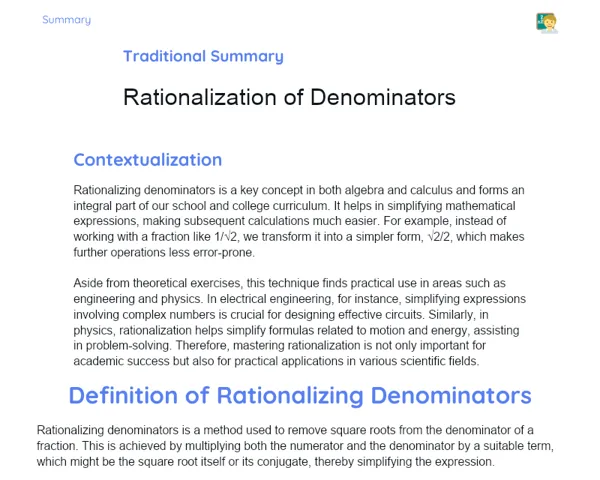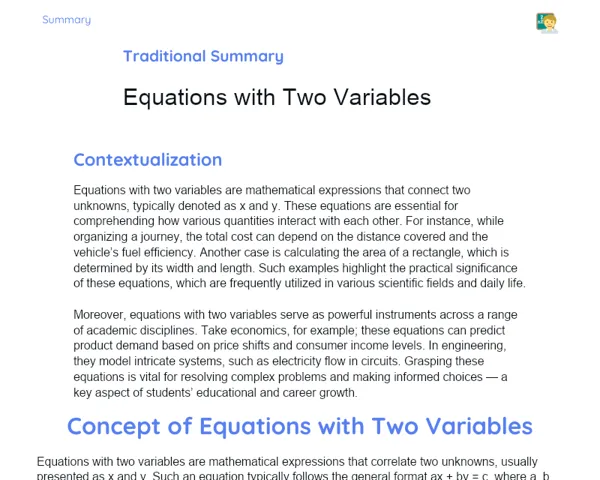Socioemotional Summary Conclusion
Goals
1. Understand the concept of circumscribed polygons
2. Relate the side of the circumscribed polygon to the radius of the circle
3. Develop skills to solve problems involving circumscribed polygons
Contextualization
Have you ever thought about how engineers come up with designs for vehicle wheels or machinery gears? Grasping the idea of circumscribed polygons is key to making sure everything runs smoothly! Picture the circle as a 'belt' that perfectly surrounds the polygon, keeping everything aligned. Let’s unravel this fascinating mathematical concept together! 🌟
Exercising Your Knowledge
Definition of Circumscribed Polygon
A polygon is described as circumscribed around a circle when all its sides are tangent to the circle. In simple terms, the circle is positioned outside the polygon and touches each side, creating a harmonious interaction between these geometric figures. 💫
-
Sides: Each side of the polygon tangentially touches the circle at a single point. Just imagine the precision of making contact at just one exact point - that’s where geometry's accuracy shines.
-
Radius of the Circle: The radius is the length from the circle's center to any point on its edge. In our exploration, getting a grip on this measure is vital for calculating how long the sides of the polygon are.
-
Center of the Circle: This point is equidistant from all points on the circle. For circumscribed polygons, every side of the polygon is tangent to the circle around this central point, reflecting balance and harmony.
Elements of a Circumscribed Polygon
The elements of a circumscribed polygon are essential components that let us grasp and tackle challenges related to this figure. Let's delve into each element and see how it plays a role in mathematics and our daily lives.
-
Sides: Each side of the polygon serves as a tangent to the circle, illustrating the link between the flat shape (the polygon) and the curve (the circle). 💡
-
Radius: The radius of the circle is a critical measure that aids in calculating other aspects of the polygon, such as the lengths of the sides.
-
Center: The center of the circle (or circumcenter) is the essence of the shape, ensuring that all polygon sides touch the circle evenly.
Relationship Between Side and Radius
In a regular polygon circumscribed around a circle, there exists a mathematical connection that ties the length of the polygon's side to the circle's radius. This relationship is instrumental in solving geometric problems and comprehending the interaction between various components.
-
Formula: The formula
L = 2 * R * tan(π/n)lets us compute the length of a side (L) of a regular polygon, given the radius (R) of the circle and the number of sides (n). -
Practical Application: Applying this formula is crucial for tackling engineering and design issues that demand geometric accuracy, like crafting wheels and gears.
-
Socioemotional Importance: While solving problems with this formula can be a tough nut to crack, it helps nurture resilience, critical thinking, and problem-solving abilities. 🌈
Key Terms
-
Circumscribed Polygon: A polygon with sides that are tangent to an external circle.
-
Side: Each segment that makes up the polygon.
-
Radius: The distance from the center of the circle to any point on its perimeter.
-
Center of the Circle: The point equidistant from every point on the circle.
-
Side Formula:
L = 2 * R * tan(π/n)- used to determine the length of a side in a regular circumscribed polygon.
For Reflection
-
How did I feel when tackling a challenging problem involving circumscribed polygons? What insights did I gain about my problem-solving abilities?
-
In what day-to-day situations can I apply the idea of circumscribed polygons and how can that aid me in resolving issues more effectively?
-
Which socioemotional strategies (like meditation or teamwork) assisted me in managing frustrations during math tasks? How can I leverage these strategies in different areas of my life?
Important Conclusions
-
Comprehending circumscribed polygons is vital for understanding more intricate geometric concepts and solving engineering and design issues.
-
The connection between the side of the circumscribed polygon and the radius of the circle serves as a powerful tool for mathematical problem-solving and fosters critical skills like resilience and analytical thinking.
Impacts on Society
Circumscribed polygons significantly shape our modern society, especially in the fields of engineering and design. Just think of the precision needed to manufacture a wheel or gear. These mathematical principles ensure that instruments function smoothly and efficiently, minimizing failures and enhancing the safety and quality of everyday products. Beyond technical implications, the study of circumscribed polygons also bears emotional significance. Overcoming challenging problems can instill a sense of achievement and boost our confidence. These experiences help cultivate resilience and perseverance, which are essential traits for tackling personal and professional hurdles throughout life.
Dealing with Emotions
To manage your emotions while diving into circumscribed polygons, consider using the RULER method at home. Start by recognizing when you feel frustrated or anxious about a problem. Reflect on why you're feeling this way and name the emotion, maybe saying, 'I feel frustrated because this problem is hard to crack.' Next, express that emotion in a healthy way by discussing it with a friend or jotting it down in a journal. Lastly, regulate your emotions through techniques like deep breathing or taking purposeful breaks. Practicing these steps can turn frustrations into chances for growth and learning.
Study Tips
-
Go over your class notes and attempt to explain the concept of circumscribed polygons to a peer or family member. Teaching others is one of the most effective ways to reinforce your learning!
-
Practice cracking additional problems using the formula
L = 2 * R * tan(π/n). The more you practice, the more at ease and confident you'll become with the topic! -
Explore online resources, like educational videos and geometry simulators, to visualize and engage with the concepts of circumscribed polygons. Visualization is key to solidifying theoretical understanding.



